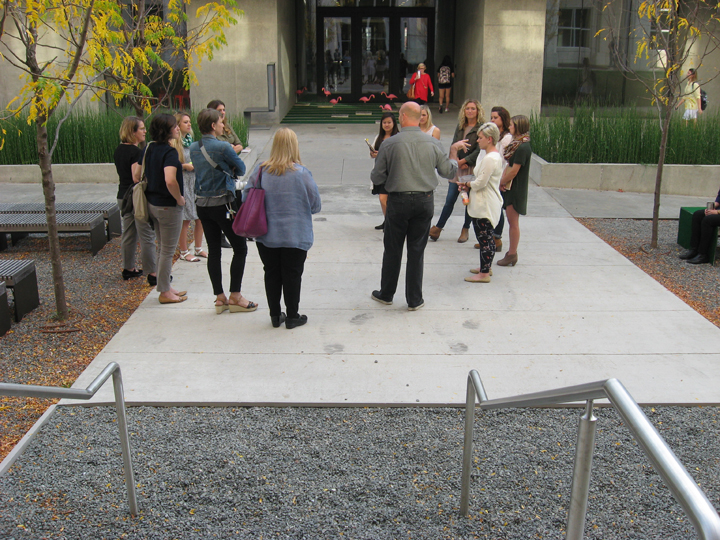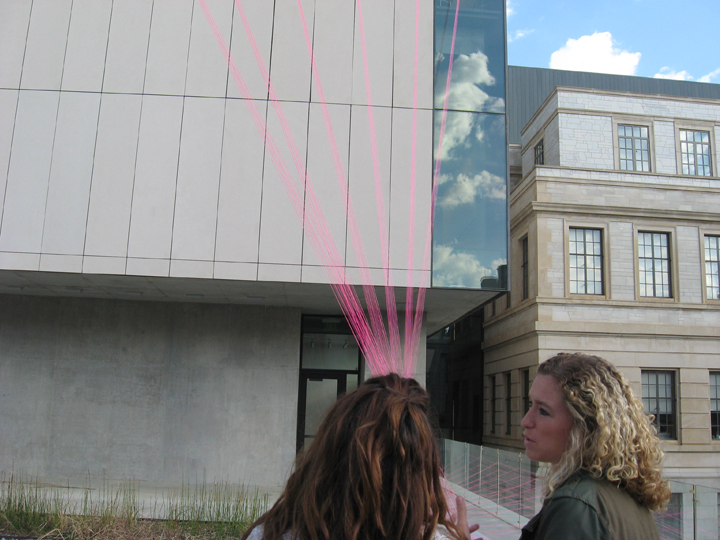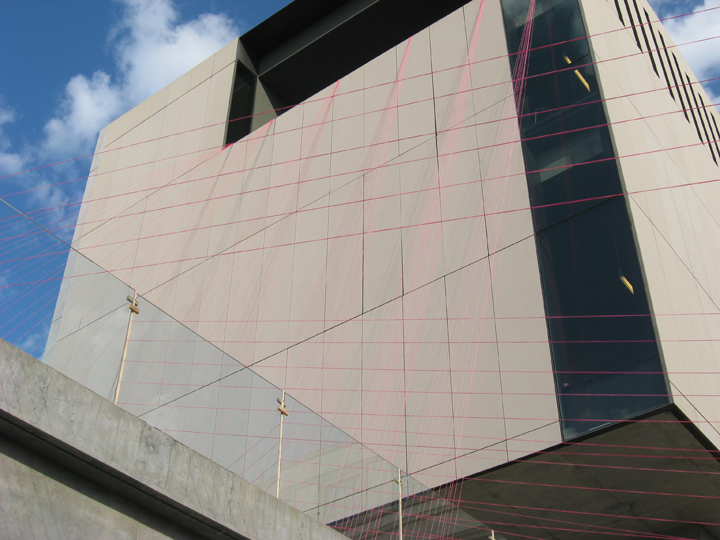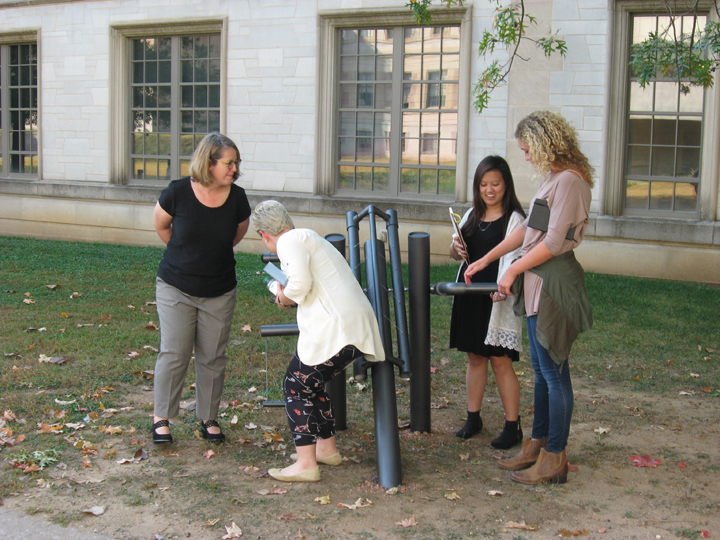
Professor Kim Furlong walks through the pink flamingo portion of Kelsey Winters and Natalie Vitek’s project. (Photo by Mattie Bailey)
By Mattie Bailey
In early October, a group of interior design students designed and created several large-scale installation projects around Vol Walker Hall, home to the Fay Jones School. In a studio led by Windy Gay, the four teams of two students each created their own take on the concept of a threshold.
The teams were comprised of Jessica Phan of Fort Smith and Jasmine Jetton of Fayetteville; Nathalie Vitek of Vienna, Austria, and Kelsey Winters of Bailey, Colorado; Emma Lambeth of Carthage, Missouri, and Kayla McKean of Little Rock; and Kelsey Fenton of Fayetteville and Elisha Taldo of Springdale.
Gay said that there were several parts to the threshold project, and the exercises were meant to have the students think “more deeply” about the spatial as well as conceptual realities of threshold.
More overall details about the threshold project can be found in this Newswire article. Below are discussions with the interior design students and more details about their designs.

Jasmine Jetton and Jessica Phan presented their large-scale installation project exploring threshold Oct. 12. They hoped to entice the busy students walking by to sit and relax and interact with the peace fountain area. (Photo by Mattie Bailey)
JESSICA and JASMINE
Their threshold intervention centered around the Fulbright Peace Fountain. They built a bench, which pulled the threshold out and built up a covered area for students to lounge. Then they topped them with 103 feet of yellow yoga mats. Their design also included covering part of the stone wall around the fountain.
“Our concept was to accentuate the threshold by pulling it up and pulling it out,” Jessica said. “We wanted to make it more inviting to people and more interactive.” She said they felt like the fountain is a very serious place, and they wanted to make the mood more energetic and fun.
Jasmine added, “We want to encourage interaction by offering more ways for people to interact with it, not just sitting on top of the threshold, but really inhabiting it.” She said the yellow ping-pong balls were to draw people in and to encourage them to pass through the threshold. Jasmine said that she and Jessica learned through their observation that threshold is a series of things, a movement from one place to another.

Jennifer Webb, associate professor of interior design, lounges in the sitting area of Jasmine Jetton and Jessica Phan’s design. (Photo by Mattie Bailey)

Nathalie Vitek and Kelsey Winter’s design includes walking through gravel, sitting on an artificial-grass-covered bench and walking through pink flamingoes. (Photo by Mattie Bailey)
NATHALIE and KELSEY
Their threshold intervention design centered on the space between Mullins Library and Vol Walker Hall. It included gravel, concrete, 240 square feet of artificial grass and six pink flamingoes. There were many tiny thresholds within their overall threshold area, Kelsey said. They realized the ways that people experience transitional materials — how they sound, how they look, the tactile feel of them — is a threshold, and that each transitional material is a threshold in and of itself. She said that people tend to memorize a space in terms of material.
“We tried to invert what people know and make them stop and take notice,” Kelsey said. People are used to stepping down from the library and walking on concrete. Suddenly, they were walking on gravel for a few days and seemed to wonder if it had always been there, she said.
The area between the buildings feels very heavy because of the concrete on all sides, Kelsey said, and their goal was to make it light and funny — hence bringing in the flamingoes. They also covered a couple of the wooden benches with bright green artificial grass to make the area more inviting to sit on.
The entrance to Vol Walker Hall was lined with the artificial grass in several strips, and flamingoes fixed in concrete and gravel-bases were intermittently placed on each of the grass strips. Nathalie said they hoped people would weave through the birds on their way to enter the building. However, she said they kept in mind accessibility to the building and left the way to one of the doors unobstructed.
“We wanted people to experience the space differently,” Nathalie said. “We thought it was really important to mix up the materials.” The area was already rich in materials, and they wanted to make people notice that.

Kayla McKean and Emma Lambeth prepare to talk about their project located at the south entrance of Vol Walker Hall. (Photo by Mattie Bailey)
EMMA and KAYLA
Their threshold intervention was the south side entrance of Vol Walker Hall and the interaction of the areas east and west of that entrance. They used 7,000 feet of nylon string in two colors of pink, and they strung it from the sky terrace at six different points and ran it fan-like down to the concrete terrace, and then down to the ground outside the bottom-level studio. Emma said they tied 144 strings to create the effect of a covering.
“People don’t even know the sky terrace is up there,” Emma said. “We felt like spiders weaving our webs at night … people would come back in the morning” and be surprised. “It was fun to do,” she said.
Emma said that she and Kayla observed people not using the space because it lacks protection from the elements and it lacks privacy because of the see-through barriers.
“Our design intervention brings attention to the lack of [protection] by creating its own sense of enclosure and also by moving out to the east, it represents the ways that your view is forced out this way,” Kayla said. She said the main goal was to not only grab people’s attention, but also to draw people to the space so it is used more than it was before.

Elisha Taldo and Kelsey Fenton present their project addressing thresholds Oct. 12. (Photo by Mattie Bailey)
KELSEY and ELISHA
Their threshold intervention project was placed on the sidewalk to the south of Mullins Library and Vol Walker Hall. It was made of several lengths of PVC pipe spray painted gray/silver and included rainmakers and a telescope. The pipes were pierced with a metal rod, which allowed the pipes to be moved up and down. The second piece was across from the larger piece and included guitar string strung in a PVC pipe square. They used 33 cans of spray paint.
Kelsey said their design was based on the trees found just a bit farther south where several sidewalks merge to create a triangular area – “a nesting area.” She and Elisha wondered what people would experience in that area if they removed their headphones and allowed themselves to experience the sound of the trees moving and the sight of the trees’ shadows.
“We were out here when it was raining and heard how the rain on the leaves sounded,” Kelsey said. She said they wanted to make things that recreated the sound of rain on leaves, so they incorporated rainmakers. They found that people really liked engaging with the rainmakers. They also built in telescopes, which could also be pointed at the second piece of their project.
“Our goal with the … threshold was recreating the sense of the two areas over there (intersection of sidewalks, surrounded by trees) and the arch of the threshold … the most important thing about the threshold was interaction, to get people to step out of their boundary,” Elisha said. She said the guitar strings on the second piece were to recreate the music wind makes.


